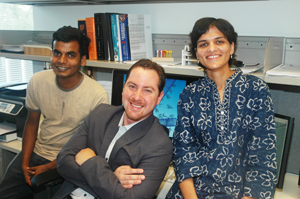A team of researchers from Rice University has taken one step forward towards developing an efficient method for dispersing nanotubes while preserving their unique properties and beyond.

The new method allows inorganic metal conjugates with different functions to be in close contact with single-walled carbon nanotubes while keeping them separated in solution.
This separation is essential for manufacturers since they are interested in making fibers from the nanotubes or blending them into composite materials to increase their strength or to utilize their electronic properties. First, the ability to change the properties of the nanotubes may advance a variety of fields, such as the development of imaging sensors, catalysis and light-based hydrogen fuel cells. And more importantly, a solution of nanotubes dispersed in water can be kept for many weeks.
Preventing the nanotubes from sticking to each other in aqueous solutions, and connecting them to other molecules that allow the addition of innovative properties, have both advantages and disadvantages for those scientists who study these very versatile materials.
The researchers tried to attach organic molecules to the surface of the nanotubes to add new properties and increase the solubility of the nanotubes. However, while these methods allow the separation of the nanotubes from one another, they take a toll on their electronic, thermal and mechanical properties.
Scientist Angel Marti, professor of chemistry and bioengineering at Rice University, and his research team report in an article published in the journal Science Chemical Communications Because ruthenium polypyridine conjugates are particularly effective in dispersing nanotubes in water for long periods. The substance ruthenium is a rare metallic element.
The researchers prepared the conjugates by connecting the metallic element ruthenium to several ligands (stable molecules that bind to metal ions). The resulting molecular coupling is partly hydrophobic - "repelling" water (the ligands) and partly hydrophilic - "loving" water (the metal ion). The ligands bind tightly to the nanotubes, while the ruthenium metal ions react with the water molecules and thus the nanotubes are kept in solution and separated from each other.
Originally, the researchers looked at the ruthenium conjugates as part of a study trying to track the amyloid protein layers associated with Alzheimer's disease. "We wondered what would happen if we changed the metallic coupling so that it could bind to the nanotubes," notes the lead researcher. "Such a result will provide increased solubility, dispersibility and change of material properties. One of my research team members mixed these conjugates together with clean single-walled carbon nanotubes and put the mixture into an ultrasonic chamber. Nothing happened - the nanotubes did not pass into the solution, they simply accumulated at the bottom of the vessel. The result was particularly surprising, but this is exactly how science progresses." In the next step, the researchers removed the liquid and added water in its place - and suddenly the solution turned black." This was due to the presence of a small amount of ruthenium.
"We found that 0.05 percent of the ruthenium conjugate is the optimal concentration for dissolving the nanotubes," the researcher notes. Further experiments showed that simple ruthenium conjugates are not sufficient to initiate the reaction. The molecule is required for its hydrophobic "tail" (the ligands) which strives for minimal contact with water through its binding to the nanotubes.
In addition, the researchers found that the original fluorescence of the nanotubes was not damaged following their connection to the ruthenium conjugates.
"The nanotubes should remain separated for weeks, without any problem," explains the lead researcher. "We have in our possession solutions that have been around for several months without any signs of disintegration."
